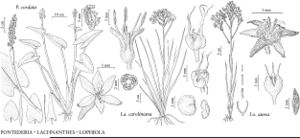Difference between revisions of "Haemodoraceae"
FNA>Volume Importer |
imported>Volume Importer |
||
| (5 intermediate revisions by 2 users not shown) | |||
| Line 70: | Line 70: | ||
|family=Haemodoraceae | |family=Haemodoraceae | ||
|illustrator=John Myers | |illustrator=John Myers | ||
| + | |illustration copyright=Flora of North America Association | ||
|distribution=e North America;Mexico;Central America;n South America;s Africa;New Guinea;Australia. | |distribution=e North America;Mexico;Central America;n South America;s Africa;New Guinea;Australia. | ||
|reference=geerinck1969a;hopper1999a;maas1993a;robertson1976a;simpson1990a;simpson1993a;zomlefer1999a | |reference=geerinck1969a;hopper1999a;maas1993a;robertson1976a;simpson1990a;simpson1993a;zomlefer1999a | ||
| Line 75: | Line 76: | ||
|publication year= | |publication year= | ||
|special status= | |special status= | ||
| − | |source xml=https:// | + | |source xml=https://bitbucket.org/aafc-mbb/fna-data-curation/src/2e0870ddd59836b60bcf96646a41e87ea5a5943a/coarse_grained_fna_xml/V26/V26_16.xml |
}}<!-- | }}<!-- | ||
-->[[Category:Treatment]] | -->[[Category:Treatment]] | ||
Latest revision as of 21:13, 5 November 2020
Herbs, perennial or rarely annual, rhizomatous, often stoloniferous; sap often red or orange. Stems simple. Leaves mostly basal, distichous, irislike; blade linear, sheathing proximally, folded lengthwise distally, folded portions becoming fused. Inflorescences terminal, cymose or corymbose, many-branched, many-flowered, loose or condensed. Flowers: tepals persistent, 6 in 2 whorls of 3, distinct above level of insertion on ovary, ± equal, aestivation valvate; stamens 3 or 6; filaments elongate; anthers basifixed, 2-locular, often basally sagittate, dehiscence introrse by longitudinal slits; pistil 1, compound, 3-carpellate; ovary inferior or half-inferior to nearly superior, 3-locular with axile placentae, or 1-locular distally with parietal placentae and 3-locular proximally with axile placentae; ovules 1, 3–6, or numerous in each locule, arranged in vertical rows or around margin of peltate placenta, orthotropous or anatropous; style 1, undivided, elongate; stigma 1, terminal, very small. Fruits capsular, dehiscence loculicidal. Seeds discoid and peltate, or elongate and variously curved; endosperm present.
Distribution
e North America, Mexico, Central America, n South America, s Africa, New Guinea, Australia.
Discussion
Genera ca. 14, species ca. 80 (2 genera, 2 species in the flora).
The two genera of Haemodoraceae found in North America are very different from each other. Lachnanthes belongs to tribe Haemodoreae and is morphologically similar to Dilatris P. J. Bergius of South Africa and Haemodorum Smith of Oceania. The relationships of Lophiola are more obscure and are discussed more fully in the references cited below and under that genus.
Selected References
Lower Taxa
Illustrations
| Family ⠉ | Taxon | Illustrator ⠉ | |
|---|---|---|---|
 | Pontederiaceae Haemodoraceae Haemodoraceae | Pontederia cordata Lachnanthes caroliniana Lophiola aurea | John Myers John Myers John Myers |
Key
| 1 | Stamens 3, longer than tepals; ovary inferior; tepals glabrous adaxially; seeds discoid, peltate, few per locule | Lachnanthes |
| 1 | Stamens 6, shorter than tepals; ovary half-inferior to nearly superior; tepals with adaxial crest of yellow trichomes; seeds elongate, variously curved, many per locule | Lophiola |